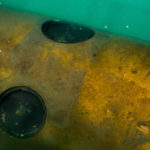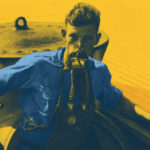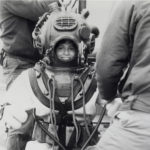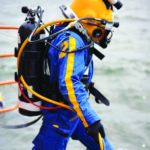
Online Exhibits
 Man of Honor: The Story of Carl Brashear
Man of Honor: The Story of Carl Brashear
Master Chief Carl Brashear rose from little to become the U.S. Navy’s first African American Master Diver and first amputee diver. With determination and persistence, he overcame poverty, limited educational access, racism, and a life-threatening injury that resulted in the amputation of his lower left leg. This exhibit follows Master Diver Brashear’s journey from a young African American teenager in segregated America, to a highly successful Master Diver and master chief in the United States Navy, to the legacy he created in life that now continues beyond his death.
 Marine Mammals: The Navy’s Super Searchers
Marine Mammals: The Navy’s Super Searchers
The Navy’s highly-trained dolphins and sea lions carry out missions all over the world. With their natural acoustic, sight, and diving abilities, marine mammals are exceptionally skilled at finding objects underwater. Navy animals detect mines and intruders in a fraction of the time it takes human divers and human-made technology. This online version of our popular temporary exhibit explores the missions Navy dolphins and sea lions perform and the science behind their remarkable abilities.
 The Remarkable Story of a Howell Torpedo
The Remarkable Story of a Howell Torpedo
In 2013, trained Navy dolphins discovered a rare 19th-century Howell torpedo buried off the coast of San Diego. The torpedo, serial number 24, is one of only five known to exist today. This online exhibit explores the history and design of Howell torpedoes, the discovery of Howell #24 by Navy dolphins, and the conservation efforts that saved the torpedo after 112 years in salt water.
 Saving Submariners: Submarine Rescue and Escape
Saving Submariners: Submarine Rescue and Escape
Discover how the Navy saves the survivors of a submarine accident in this online version of our permanent exhibit that looks at the history of submarine rescue and escape from 1900 through today. Explore the changes to submarine rescue and escape over time and discover why the U.S. Navy strongly prefers rescue over escape as the safest, most reliable method of saving submariners.
 Paving the Way: Navy Undersea Pioneers
Paving the Way: Navy Undersea Pioneers
Pioneers come in many forms. This online exhibit looks at two types of pioneers that made significant contributions to the Navy’s undersea communities. Groundbreakers and trailblazers led initiatives, broke barriers, and set records. Their achievements inspired many who hoped to follow in their footsteps and paved the way for others to build on their accomplishments. Inventors and innovators were visionaries that imagined and designed new technologies, expanding the Navy’s capabilities.
 NEDU: Rising to the Challenge
NEDU: Rising to the Challenge
The Navy Experimental Diving Unit (NEDU) has safeguarded Navy divers and expanded their diving capabilities since 1927. Its official mission is to research, develop, test, and evaluate diving equipment and procedures, but more simply, its job is problem-solving: NEDU personnel use their expertise and experience to find solutions for the many challenges of working underwater. Learn how NEDU’s many accomplishments have extended the depth, duration, and safety of Navy diving.
 Women Divers: Part of the Navy Team
Women Divers: Part of the Navy Team
Women joined the Navy diving community in 1975. Through determination, persistence, and a love of diving, these early pioneers proved themselves in a male-dominated world to become valued, respected members of the diving community. Learn about the challenges and achievements of some of the first female Navy divers in this online version of our popular past museum exhibit.
 The Skin They’re In: U.S. Navy Diving Suits
The Skin They’re In: U.S. Navy Diving Suits
The undersea world can be cold, threatening, and dangerous. Navy divers work worldwide in conditions ranging from arctic ice to tropical waters. To keep themselves safe and comfortable, they use diving suits to get the protection their own skin does not provide. This online version of a past temporary exhibit examines why Navy divers need diving suits and how they use them.
